|
There are some differences in the way that Thai artists from various parts of Thailand work for Buddhist arts. Many people are curious why a large amounts of money are spent extravagantly on constructing so many temples rather than donating to local hospitals or schools which are more necessary for solving current social problems.
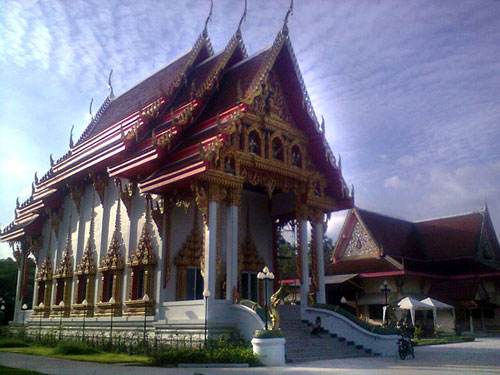
At present, it is said that a main reason to build temples is not so much different from the past. It is actually part of the strong faith for Buddhism. Around 30 temples are built behind the old city's brick walls of Chiang Mai and we can see more temples spreading throughout the entire city area every one or two kilometers from the city center.
In the past, there was disagreement regarding the construction of temples as an ongoing tradition. Although the economy in Thailand at that time was in really bad condition, Buddhists still donated money to build more temples. Now as then, they strongly believe that building temples is a good way to support Buddhism. Moreover, artists have great opportunities to preserve arts and present legends and tales about Buddhism in all the temples in the form of murals and sculptures. It follows that building a temple is a way to create opportunity and income for local artists. Those artists have the diligence and patience to create beautiful and interesting works of art according to the overall concept of their employers who are usually the head monks who raised the money from the donations
Such artistic works are specifically created to preserve and prolong the existence of Buddhism in Thailand as long as possible.
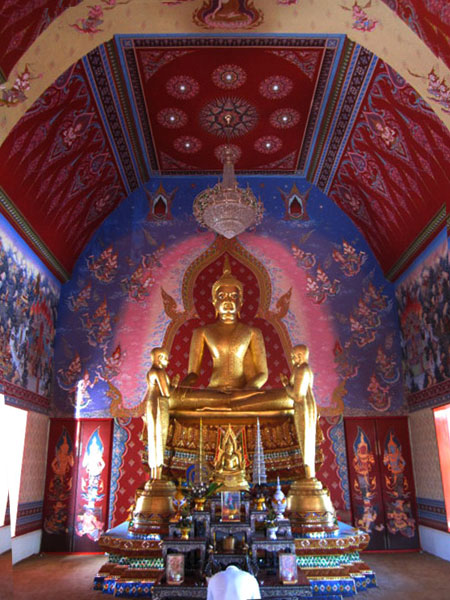
Buddhists believe in Karma, and believe in rebirth. People donate money in expectation of a better future life. Karma is the result of past lives—sometimes we know or don't know why bad things or good things happened.
Nakhon Si Thammarat is a province that has much significance in Buddhist history. History records that the first arrival of Theravada Buddhism in Thailand took place there. The city was settled in the same period of the founding of the Sukhothai Empire (around 700 years ago). After that, Buddhism became the main religion of Thailand until present-day and remains a significant part of the Thai way of life.
Last month I had a conversation with a team of Thai artists from the south of Thailand. Currently they are working in Nakhon Si Thammarat province and their works are mainly decorations, murals and sculpture for old and new temples in the southern and central regions of Thailand. This group of energetic artists have broad experience in stucco decoration, sculpting statues and mural painting. Their site allows them to work up in the hills, the place which scientists reported has "The best ozone in Thailand."
Here is a brief interview with Chalermchai Heepphet, one of the team's leaders. It was an opprtunity to ask him about the work and the way Thai artists create their dreams and make their living .
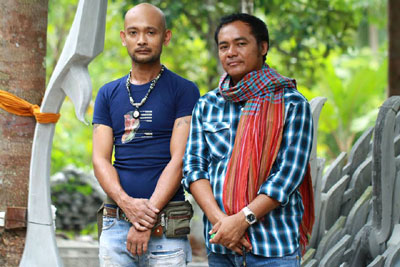
JY: What do you think about building a temple as a way of making merit?
CI: This is a primary part of Buddhists' belief and a commitment that we need to support Buddhism to reach its zenith of 5,000 years. The Buddhist era is now in the year 2556 and we have already passed the half way mark.
JY: There is another issue about Buddhism's belief that I would like to talk about: when we die and then are born again in the next life. According to Buddhism, people are born to repay the good and bad Karma (action) from their past lives. In addition, the good and bad Karma they did in their past lives will determine the overall wellbeing in their present lives.
Besides supporting Buddhism, it seems that lessening the suffering of people as well as acquiring happiness and wealth are minor reasons why some Thai people spend so much money on building new temples and improving existing temples. Many people believe that this tradition brings too many troubles for Thai society and they disagree with it.
As I said earlier, in Chiang Mai there are many temples and I am sure that there is the same tradition in many provinces.
In my view, I personally have no problem with the construction of more temples but the donation money for some temples cannot be scrutinized and this is really a bad practice. If there is corruption in a particular temple during the construction and donation money is lost or stolen, many donors fear that the temple won't be finished as they intended.
Your team works in many provinces in the south and central regions of Thailand. I would like to know more about stucco and painting works and if the artists have the freedom to express their imagination fully?
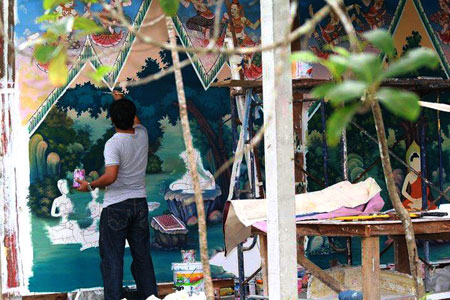
CI: In the south of Thailand most artists graduated from art colleges and universities. Khun Komol Damnoenphol, the project leader, also graduated from an art school in Nakorn Si Thammarat province. These art institutions encourage students to study and appreciate Buddhism including legends from literature about Buddhism. They also learn about the life of the Buddha before he achieved enlightenment. Nakorn Si Thammarat is the province in Thailand that Buddhism appeared for the first time and was the hometown of a famous poet, Sriprach. This province is capable of sending out artists with outstanding sculpting and painting skills to work anywhere in Thailand. The role-model artist who was the inspiration for all art students was Professor Silp Bhirasri from Silpakorn University.
JY: There is an interesting issue about how artists work in each region. All artists can paint murals and sculpt statues well. As can be seen from some temples in the north, the mural paintings show the ways of life and traditions of Thai people in the past along with some comical gimmicks that were inserted in the murals intentionally. On the mural wall of Wat Buak Krok Luang temple, we can see paintings of foreigners standing near the lake. In Wat Phumin temple in Nan province, there is a mural of a northern woman in traditional clothing smoking a big cigar and talking to a man. In Wat Phra Singh temple in Chiang Mai, around the border of a mural wall painting are pictures of intimacy between a man and a woman as well as two men. In Wat Thung Saliam temple, people can read about world history and see the pictures of four American robots from Hollywood movies in the murals. It seems that at present artists who paint murals have more freedom to insert some modern ideas in their work.
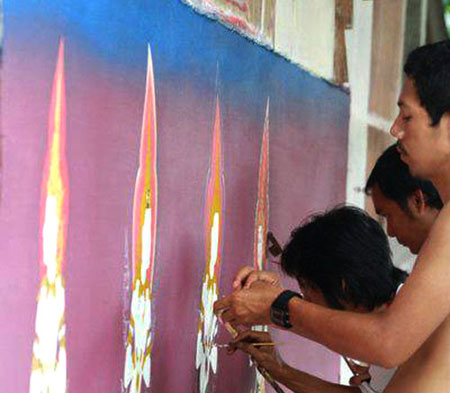
CI: In the south of Thailand artists have a different concept. We focus only on traditional ideas and are very conservative about what to draw in the mural paintings. Everything is an agreement between the head monks who design the overall projects and the artists who have to make them possible according to the requirements. Actually artists can propose their own interesting and creative ideas but everything has to be based on the stories of Buddha's life. Therefore, some new changes cannot be done because we have to maintain the value of traditional art and we hope to preserve Buddhism to reach the goal of 5,000 years.
JY: Some temples in Thailand use different techniques apart from using stucco which is the traditional technique to decorate a temple. Some temples use bare bricks and paint the temples with light colors in the same method of European architecture. I think those temples are also as beautiful as traditional temples. Do you think that temple design in Thailand will change to the newer styles? Has your team ever done different styles of temples?
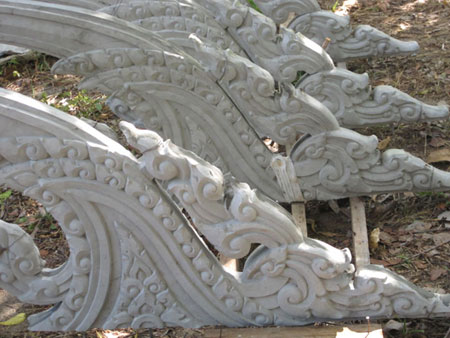
CI: My team and I have never done this. But at Wat Rong Khun in Chiang Rai province there was the project of Ajarn Chalermchai Kositpipat, a famous painter. He tried to use a different style of temple building. As I said before, most temples in the south of Thailand are built in traditional style and with familiar art concepts. As for the issue of styles, I believe it depends on the decisions of the employer or project owner. Both traditional and creative styles have the same purpose — to preserve Buddhism.
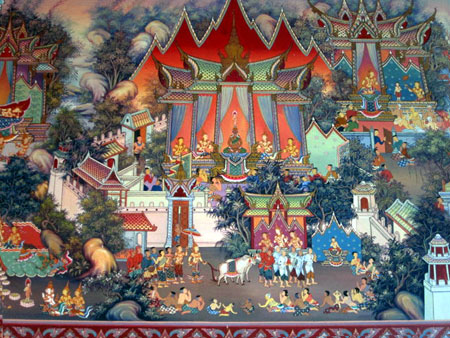
JY: Does your team spend too much time on building each temple? What is the happiness you get from your work?
CI: Working as a team is my absolute happiness because our work finishes on time and completes all of its goals. We separate our team to work in many provinces but everyone has the same goal and the same faith.
JY: Next time I hope to see more works of artists in the south of Thailand. I also thank you for your answer which is the same as all Buddhists who understand the importance of building temples. This commitment is essential for Buddhism in the long run. In addition, this also affords the distribution of income to many poor villagers and artists. The result is land development to build more roads and infrastructure to connect with the temples. Overall wellbeing of the villagers will improve more than ever. New local artisans and artists are properly trained and hired to help finish the project faster. More importantly, some of the money from each temple also supports local schools, hospitals and funeral events. This is the fact that many people ignore completely and this way is so much better than giving money to a bad monk or anyone who tries to take advantage of the donation money and spend it in inappropriate ways. This kind of wrongdoing makes some people think that building a temple is a waste of money and useless. When the way of the believers are different and Thai hearts believe the leader abbot, it happens that people in yellow robes take advantage of the money and taint the way of Thai life.
To counter such problems, we have to scrutinize the donation money and try to donate money to good people who have good hearts and truly want to build temples to preserve Buddhism.
|